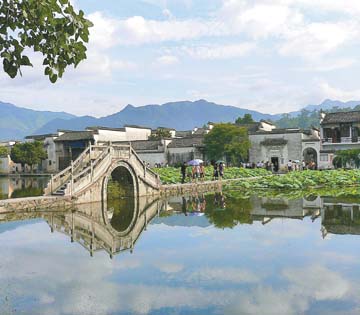CHINA’s long and complex history has given rise to 10 types of architecture. They not only fuse different structural and decorative forms, but are also influenced by Chinese concepts such as fengshui and yin and yang. 
Dayi Liu Manor A typical Sichuan manor that started construction in 1932, Dayi Liu Manor is located in Dayi County, Chengdu, Sichuan Province. The layout is complicated with winding paths, showing how the Liu family occupied farmers’ land and expanded the manor. The 70,000-square-meter manor has 545 rooms. The advanced architecture features pavilions, attics, buildings with painted pillars and doors carved with attractive patterns, including animals, flowers, plants and auspicious images. There are thousands of cultural relics in the manor. It is regarded as an important place to study and research the semi-feudal and semi-colonized society, cultural buildings, the warlord history and folk customs of China. Transport: Fly to Chengdu City in Sichuan Province from Shenzhen International Airport, then take a bus to Dayi Liu Manor Accommodation: There are hostels and inns around the local scenic spots in Chengdu. Cuisine: Try wild vegetables, hotpot, barbeque, dumplings and noodles. Chengdu is known for its wide variety of snacks. Hongcun Village The ancient Hongcun Village, situated next to Huangshan Mountain in Qianxian County, Huangshan City, Anhui Province, resembles a sleeping ox nestling among green mountains and rambling rice fields. It is called “a village in the Chinese painting” thanks to its scenery. Hongcun Village is also one of the locations for the film “Crouching Tiger, Hidden Dragon” directed by Ang Lee and starring Chow Yun-fat. It is famous for its water-supplying system constructed during the Song Dynasty (960-1279). Now it boasts 158 houses dating back to the Ming (1368-1644) and Qing (1644-1911) dynasties, of which nearly 140 are still in good condition. Villagers have a strict timetable for each specific need of water. Before 7 a.m., water is used for drinking and cooking only. From 7 to 9 a.m., it is for cleaning vegetables and other daily purposes, after that it is taken to the front yard to water livestock and wash clothes. Transport: Fly to Huangshan City in Anhui Province from Shenzhen International Airport, then take a bus to Qianxian County and Hongcun Village. Accommodation: There is a wide selection of hostels and inns in Qianxian County. Cuisine: Fish, bean curd and wild vegetables are recommended. Xidi Village Xidi Village, built during the Song Dynasty (960-1279), is in Huangshan City, Anhui Province. It is known for the ancient treasures of the vernacular architecture. It was declared a world heritage site by UNESCO in 2000, along with Hongcun Village. Today, 124 well preserved wooden residences from the Ming (1368-1644) and Qing (1644-1911) dynasties with beautiful carvings form a major attraction. Many of these residences are open to the public. The rise of the village was closely tied to the fortunes of the Hu family, which started as merchants and expanded into politics. The prosperity of Xidi Village peaked in the 18th and 19th centuries, when the village comprised about 600 residences. The street pattern of Xidi is dominated by a main road which runs in an east-west direction and is flanked by two parallel streets. These major streets are joined by many narrow alleyways. Transport: Fly to Huangshan City in Anhui Province from Shenzhen International Airport, then take a bus to Xidi Village. Accommodation: Stay in a hostel or with the locals. Cuisine: Fish, bean curd and wild vegetables are recommended. (Jane Lai) | 
